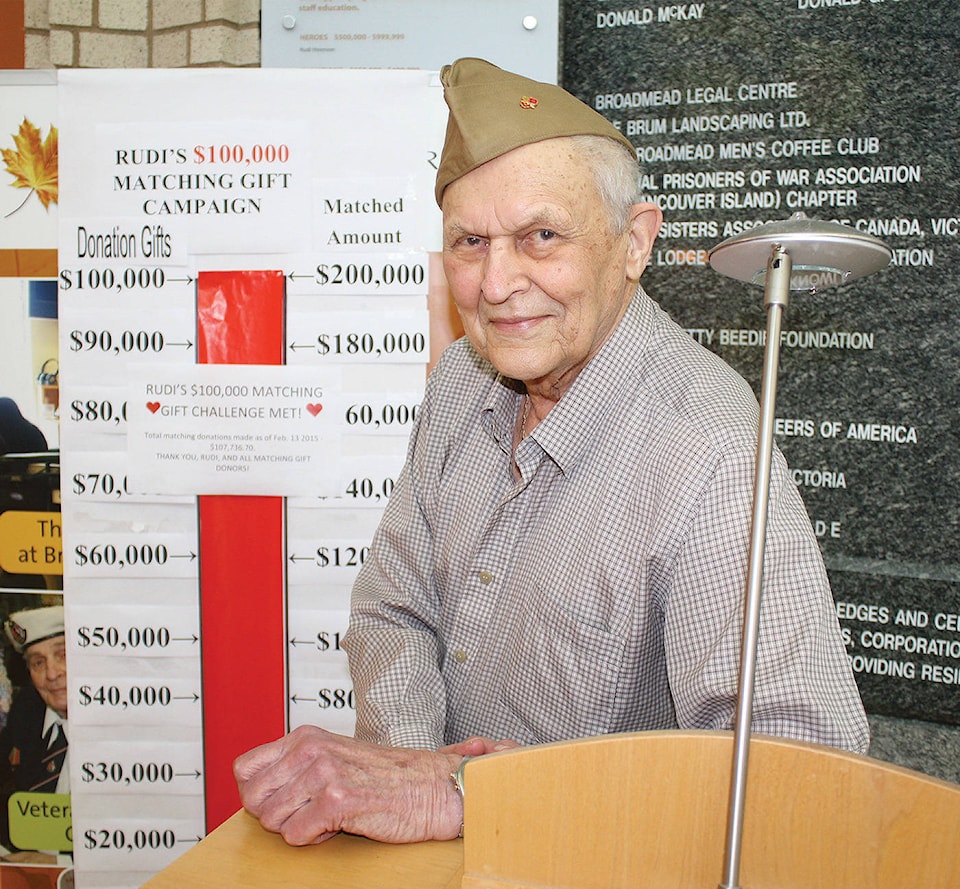Rudi Hoenson remembers Aug. 9, 1945 like it was yesterday.
The scorching heat of flames, the cries of the injured and the smell of burning flesh after the first atomic bomb was dropped by the United States on Nagasaki, Japan are memories the 94-year-old survivor will never forget.
This week marks the 72nd year since the bombing of Hiroshima on Aug. 6, 1945 and Nagasaki, which ended the Second World War. Hoenson, who continues lives with the images of people suffering, hopes that historic day that affected 199 Dutch prisoners of war will never fade from public memory.
“It’s important to do it just for the 199 guys that did not make it that are dead,” said Hoenson, a Greater Victoria resident and local philanthropist.
“What made me mad is nobody knows about it. There’s no articles, no movies, nothing. Nobody ever said anything about these 199 guys.”
Hoenson joined the Dutch army at the age of 18 shortly after the bombing of Pearl Harbour on Dec. 7, 1941. He was deployed to Java, Indonesia and after seven days of holding off the Japanese, were ordered to surrender.
He fought the Japanese in the Indonesian jungle before he and about 500 Dutch soldiers were caught and imprisoned. He remained a prisoner of war for three and a half years, until U.S. soldiers showed up a month after the war’s end in 1945.
For the next three-and-a-half years, Hoenson would be a prisoner of war, working in Nagasaki as an electric welder.
On the day of the bombing, Hoenson was one of 200 prisoners forced to clean up the rubble from a previous airborne attack. At 11:02 a.m., he remembers looking up to the sky and seeing a B-29 bomber drop three parachutes. Suddenly, he was knocked off his feet by a powerful blast.
Hoenson woke shortly after to a scene of mayhem.
Houses were on fire, trapping occupants within them, and women and children were badly burned and bleeding, screaming for help. Two other prisoners of war, who were with Hoenson at the time, were burned badly. Hoenson also suffered burns on his legs, but was able to walk. He was 1.3 kilometres from the epicentre of the blast.
“That was the worse part, to see those women. Their skin was no longer soft and white. Their kimonos were so flimsy, and were blown apart to nothing, and they were bleeding,” he said.
In the days following, Hoenson and other prisoners were forced to move dozens of bodies so Japanese authorities could identify them. He also collected skirts and shirts from the dead to make bandages for the wounded. The bomb killed an estimated 40,000 people.
It wasn’t until a month later in which Hoenson was rescued and returned to Holland, eventually moving to Canada and settling in Victoria in 1979.
More than seven decades later, Hoenson still questions how he was one of the few who survived the blast.
Of the 199 prisoners that Hoenson was with the day of the bombing, many later died from their injuries, leukemia or other illnesses. He also never had children after doctors advised him they could be severely deformed due to the amount of radiation he was exposed to that day.
To help keep those memories alive, Hoenson will read his poem “Atomic Lament” during the Hiroshima Nagasaki commemoration. put on by the Vancouver Island Peace and Disarmament Network and the Physicians for Global Survival, the event takes place Wednesday, Aug. 9 from 6:30 to 9 p.m. at Esquimalt Gorge Road Park (1070 Tillicum Rd.)
The event also includes lantern making, an art exhibition and performances by the Nikkei Society-Furusato Dancers, as well as the Getting Higher choir. The evening will end with the release of lanterns as a prayer for peace. For more information, visit vipdn.org/events.



